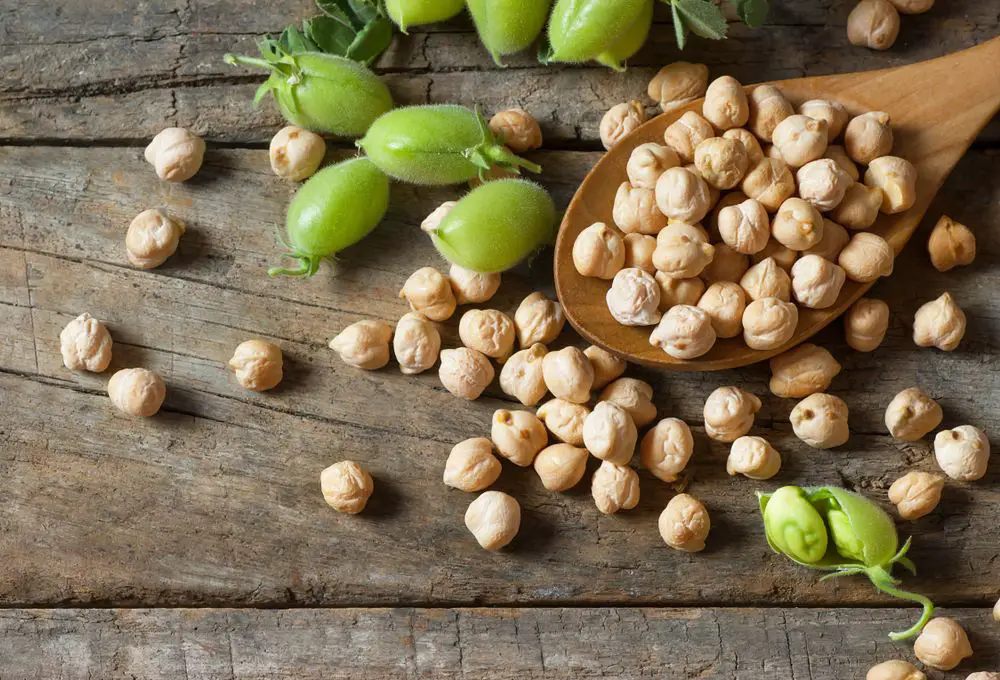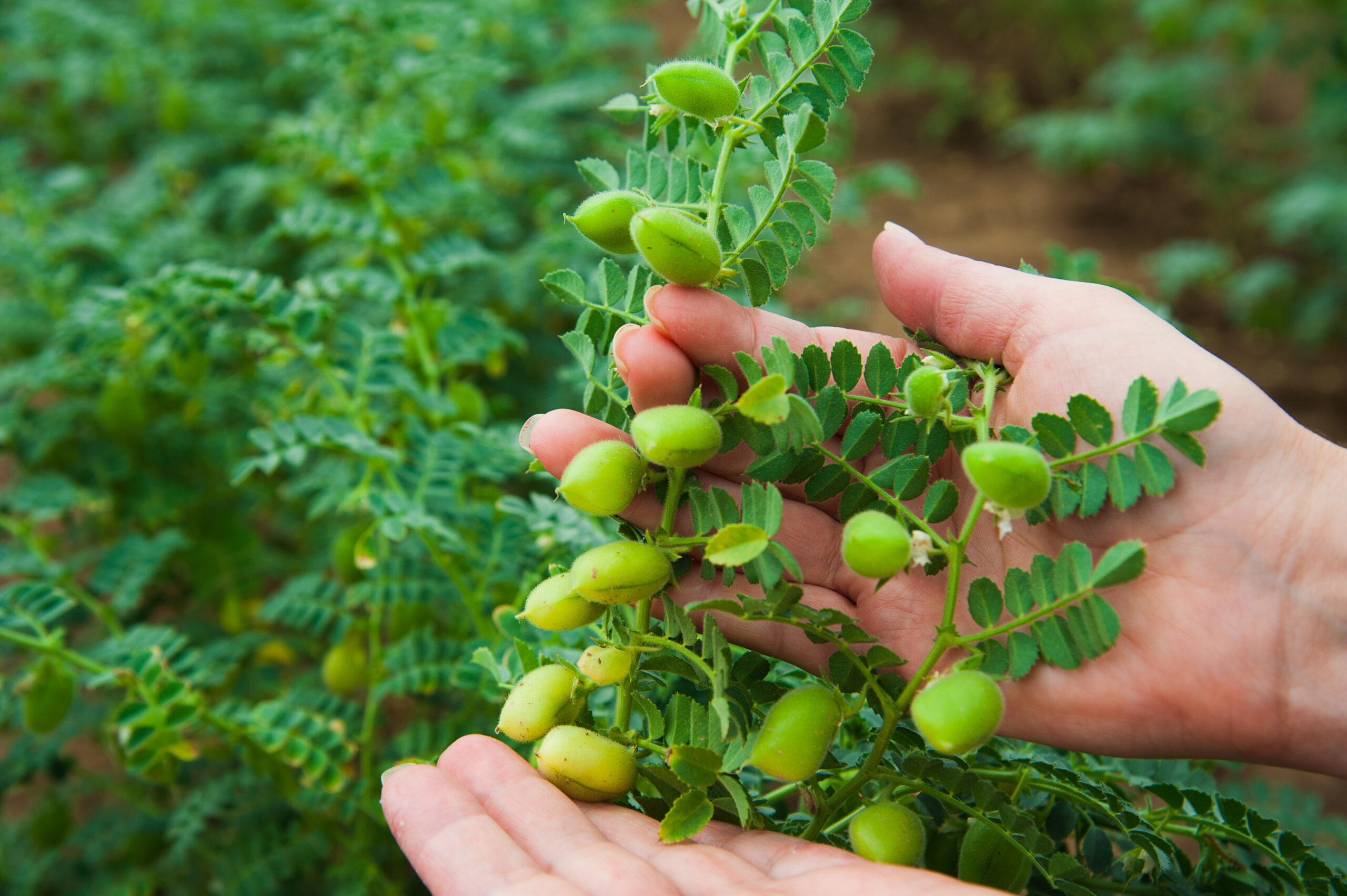Chickpeas, also known as Garbanzo beans, may have an unusual appearance, but these protein powerhouses have a deliciously nutty flavor and are also healthy. Skip the canned variety and cultivate your own at home for the greatest flavor.
The step by steps for planting Chickpeas are to prepare the space, inoculate the seeds, plant the seeds, water them, and thin out the seedlings. Nutritious, great tasting, and utterly versatile Chickpeas – what a treat to have them freshly grown.
Step By Step Guide in Planting Chickpeas
Chickpea plants are bushy and reach a height of around 18 inches, making them perfect for pots. The “peas” are seeds that are enclosed in little pods that develop on the plant.
They are a cool-season crop that thrives in temperatures between 70 and 80 degrees during the day and above 65 degrees at night.
Since Chickpeas are a frost-tolerant cool-weather plant, the optimum time to start them is in early spring, about a week before your area’s last frost date. When the weather permits:
Also known as Garbanzo beans, they’re a wrinkled, mid-sized legume (Fabaceae) family member that is frequently referred to as “Pulses.”
They are divided into two types: Desi and Kabuli. The form, size, and color of the bean are used to classify each kind.
The most popular form of Chickpea to cultivate in a home vegetable garden is Kabuli Chickpeas. Plant the cool-weather crop just before the growing season’s last frost date
1. Get the Planting Space Ready
Chickpeas should be planted in full light.
In partial shade, Chickpeas will grow, but the production will be diminished.
Chickpeas should be grown in soil that is loose, well-drained, and rich in organic matter. Before planting, add old compost to the planting beds.
Chickpeas should not be planted in soil that has recently developed green manures or in soil that is heavy in nitrogen; this will result in green leafy growth rather than seed production.
2. Inoculate the Seeds
Mix your Chickpea seeds with the inoculant Rhizobium leguminosarum, which is commercially available at many garden stores, if you wish to inoculate your Chickpeas to boost your output. Before planting, allow the seeds to dry in the shade.
3. Plant The Seeds
Chickpea seeds should be planted in rows with two inches deep in each hole and three to five inches between each hole. While the plants may appear to be close together, the little crowding helps them to support and grow.
Chickpeas can be planted in the garden as early as two or three weeks before the typical last frost date in the spring. It’s vital that you should get a head start because Chickpeas have a lengthy growth season.
4. Water It
After planting, water the area lightly to settle the soil and keep it evenly moist for germination. As the seeds germinate, avoid watering them too deeply: too much moisture can cause the seeds to crack.
5. Thin It
Once your Chickpea seedlings are approximately three inches tall, thin them by picking up any seedlings growing immediately opposite each other, keeping four to six inches between plants.
Tips In Growing Chickpeas
If you’re new to growing Chickpeas, here are some pointers to help you have a better harvest:
Time to Plant
Chickpea is a cool-season annual that takes around 100 days to mature. Chickpeas are frost resilient, although they thrive at temperatures between 70 and 80 degrees Fahrenheit (21-26 degrees Celsius) during the day and 65 degrees Fahrenheit (18 degrees Celsius) at night.
Spacing and Planting
Sow Chickpeas at a depth of 112 to 2 inches (5cm) and 3 to 6 inches (7-15cm) apart. Successful plants should be pruned to 6 inches (15cm) apart; thinned plants should be cut away at soil level with scissors to avoid disturbing roots.
To prevent seeds from breaking, do not soak seeds before sowing and avoid excessive watering after sowing. Chickpeas that have been allowed to become a little crowded will help each other.
Plant Companion
Chickpeas grow well with most garden plants because they are nitrogen-fixers, which means their roots have healthy bacteria-filled nodules that replace the soil with nitrogen.
Cucumbers and Summer Savory are popular companion plants.
However, Chickpeas should not be planted near Alliums (particularly garlic) because they emit a chemical that hinders legume development.
Plant Chickpeas away from plants that are prone to the same diseases, such as potatoes or soybean plants.
Handle in Drier Seasons
Since Chickpea plants are prone to fungus, especially when wet, avoid touching the leaves or pods after rain or morning dew to prevent the fungus from spreading from plant to plant.
When manipulating the roots, be gentle. Because Chickpea plants have shallow root systems, it’s best to avoid disturbing them.
When weeding, pluck off roots towards the base of the Chickpea plants gently.
Consider Inoculation
Inoculating the seeds with a special bacterium that helps encourage nitrogen fixation, strengthens the plant. Improving yield is a step that some pulse crop growers add to their planting routine.
Mix the Chickpea seeds with the inoculant Rhizobia cicero, which is commercially available at many garden stores, to inoculate your Chickpeas. Before planting, allow the seeds to dry in the shade.
How to Take Care of Chickpeas
After your Chickpea plants have grown, you can take care of them as follows:
Proper Watering
Chickpeas like their soil somewhat dry; too much water will destroy the plants rapidly. Use a watering can with a long spout to water the base of the plants directly rather than an overhead watering method, which will wet the leaves and pods and increase the risk of fungal rot.
Controlling Pests
Aphids, leafhoppers, mites, flea beetles, and bean beetles may all eat Chickpeas. Individual bugs should be pinched off the plants or removed with a blast of water; for infestations, a natural insecticide should be used.
Monitor Diseases
Ascochyta blight, bean mosaic virus, and anthracnose are all fungal or bacterial illnesses that can affect Chickpea plants. Keep an eye on your plants for unusual coloring, leaf death, or misshapen growth.
If a plant shows signs of infection, it should be removed to prevent the infection from spreading. After rain or morning dew, avoid handling the leaves or pods, as this can spread the fungus from plant to plant.
Gently Weed
If weeds appear among your Chickpea plants, gently pull them out; Chickpea plants have shallow root systems, so you don’t want to disturb them.
How To Harvest Chickpeas?
Your Chickpeas should be ready to harvest about 100 days after sowing:
Pull & Dry The Plants
Your Chickpea plants will begin to wither and turn brown after 100 days. Pull the Chickpea plants out of the ground and set them on a mat or in a container in a bright, dry location outside or in a room with adequate air circulation. The pods should split naturally as they dry, revealing the Chickpeas inside.
Gather the Seeds
Remove the plants from the mat or container when the majority of the pods have cracked and collect the seeds that have fallen. Check the stems for any leftover seeds that haven’t fallen, then split open the pods using your fingers to gather the dry Chickpeas.
Store It

Chickpeas shelled and dried, should be stored in an airtight container in a cold, dry location. Chickpeas that have been dried can be stored for up to a year.
Fresh Chickpeas (also known as “green Chickpeas”) can be eaten right off the plant when the pods are still green and immature.
Final Thoughts
Who doesn’t love the great – almost nutty flavor – of Chickpeas? We hear the word Chickpea and more than a dozen recipes float off the tongue; recipes in which they are used, but not everyone would recognize them.
Chickpeas – or any of the Pulses – are incredibly healthy for you and contain a good deal of protein. Being highly nutritional, they are great for vegetarians and for meat eaters alike.
They are favoured in Middle Eastern recipes, and Indian, Greek, Mediterranean and European dishes
We’re off to plant some now because our mouths are watering with the thought of a splendid helping of a good Chickpea dish! Don’t miss out on this fabulous food.
Jenny Marie
Tribal Writer
Edited By
Patricia Godwin

